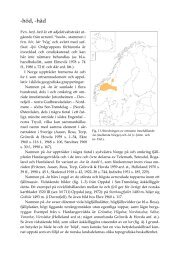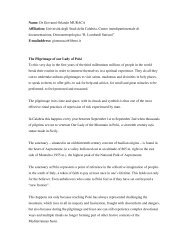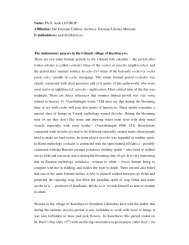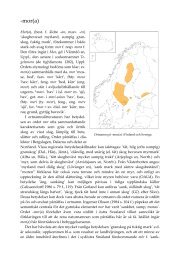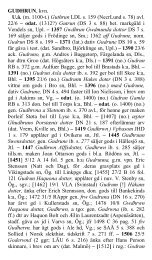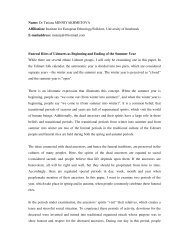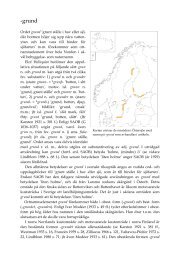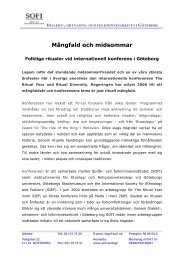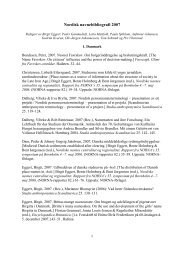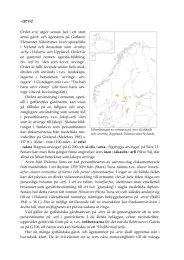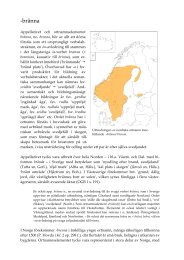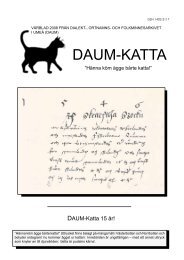The Roots and the Meaning of the Custom The Ride of the Kings in ...
The Roots and the Meaning of the Custom The Ride of the Kings in ...
The Roots and the Meaning of the Custom The Ride of the Kings in ...
You also want an ePaper? Increase the reach of your titles
YUMPU automatically turns print PDFs into web optimized ePapers that Google loves.
Name: Ph.D. Jan RYCHLIKAffiliation: Faculty <strong>of</strong> Arts, Charles University, PragueE-mailaddress: rychlik@email.cz<strong>The</strong> <strong>Roots</strong> <strong>and</strong> <strong>the</strong> <strong>Mean<strong>in</strong>g</strong> <strong>of</strong> <strong>the</strong> <strong>Custom</strong> <strong>The</strong> <strong>Ride</strong> <strong>of</strong> <strong>the</strong> <strong>K<strong>in</strong>gs</strong> <strong>in</strong> MoraviaIn <strong>the</strong> Moravian Slovakia (<strong>the</strong> border region <strong>in</strong> <strong>the</strong> South-East part <strong>of</strong> <strong>the</strong> Czech republic, at<strong>the</strong> border with Slovakia) exists <strong>the</strong> unique custom called <strong>The</strong> <strong>Ride</strong> <strong>of</strong> <strong>the</strong> <strong>K<strong>in</strong>gs</strong>. (Jízda králu˚<strong>in</strong> Czech). In <strong>the</strong> past this tradition was frequent <strong>in</strong> <strong>the</strong> whole region, now it exists only <strong>in</strong> fewvillages. <strong>The</strong> best known is <strong>the</strong> ride <strong>in</strong> Vlcˇnov near Uherské Hradisˇteˇ.<strong>The</strong> ride takes place <strong>in</strong> June <strong>and</strong> historically is connected with <strong>the</strong> Whitsun week (Pentacost)customs. <strong>The</strong> ceremony takes place usually on Sunday. <strong>The</strong> group <strong>of</strong> young men <strong>in</strong> old folkcostumes dressed as women drive <strong>the</strong> horses through <strong>the</strong> village while o<strong>the</strong>rs are go<strong>in</strong>g along<strong>the</strong>m. Some jackets are fastened with gleam<strong>in</strong>g buttons, o<strong>the</strong>rs hang open, <strong>and</strong> <strong>the</strong>re are men<strong>in</strong> shirtsleeves as well. <strong>The</strong> central personality <strong>in</strong> <strong>the</strong> procession is „<strong>the</strong> K<strong>in</strong>g“,a young boy not older <strong>the</strong>n fifteen, driv<strong>in</strong>g <strong>the</strong> horse with his face veiled <strong>and</strong> eyes bond by ared kerchief. He does not see anyth<strong>in</strong>g <strong>and</strong> <strong>the</strong> horse must be carefully tra<strong>in</strong>ed for <strong>the</strong> ride <strong>and</strong><strong>the</strong> o<strong>the</strong>r riders must take care about both <strong>the</strong> K<strong>in</strong>g <strong>and</strong> <strong>the</strong> horse. <strong>The</strong> K<strong>in</strong>g keeps a red rose <strong>in</strong>his mouth which means that he cannot speak. <strong>The</strong> horse riders <strong>and</strong> o<strong>the</strong>r participants ares<strong>in</strong>g<strong>in</strong>g <strong>and</strong> play<strong>in</strong>g on different <strong>in</strong>struments collect<strong>in</strong>g food, dr<strong>in</strong>ks <strong>and</strong> money for “ourpauper K<strong>in</strong>g, a righteous one”. <strong>The</strong> whole ceremony has a form <strong>of</strong> carnival or folk <strong>the</strong>atre <strong>in</strong>open air. <strong>The</strong> songs are humorous, sometimes with erotic connotation <strong>and</strong> full <strong>of</strong> logicalcontradictions. <strong>The</strong> peregr<strong>in</strong>ation through <strong>the</strong> village takes sometimes several hours.Nobody knows exactly what <strong>the</strong> <strong>Ride</strong> <strong>of</strong> <strong>the</strong> <strong>K<strong>in</strong>gs</strong> orig<strong>in</strong>ally meant. <strong>The</strong>re is an old legendconnect<strong>in</strong>g <strong>the</strong> <strong>Ride</strong> <strong>of</strong> <strong>the</strong> <strong>K<strong>in</strong>gs</strong> with <strong>the</strong> political events <strong>in</strong> <strong>the</strong> second half <strong>of</strong> <strong>the</strong> 15 thCentury: when Matthias Corv<strong>in</strong>us, K<strong>in</strong>g <strong>of</strong> Hungary, was defeated <strong>in</strong> <strong>the</strong> Iron Mounta<strong>in</strong>s by<strong>the</strong> Bohemian K<strong>in</strong>g George <strong>of</strong> Podeˇbrady, he had to flee. On his way to Hungary both <strong>the</strong>k<strong>in</strong>g <strong>and</strong> his soldiers had to hide from <strong>the</strong>ir Bohemian pursuers <strong>in</strong> Eastern Moravia <strong>and</strong> beg forbread. <strong>The</strong> legend is certa<strong>in</strong>ly not true, because Matthias did not flee after <strong>the</strong> battle but was
surrounded <strong>and</strong> captured by George <strong>and</strong> <strong>the</strong>n let to go home freely. Also, <strong>the</strong> event took placeon 26 February 1469, e.g. <strong>in</strong> <strong>the</strong> W<strong>in</strong>ter, not dur<strong>in</strong>g <strong>the</strong> Whitsun week. <strong>The</strong> tradition <strong>of</strong> <strong>the</strong><strong>Ride</strong> is certa<strong>in</strong>ly much older <strong>and</strong> probably goes back to <strong>the</strong> pagan times.<strong>The</strong>re are number <strong>of</strong> hypo<strong>the</strong>ses but none <strong>of</strong> <strong>the</strong>m has been proved. In my paper I deal withsome <strong>of</strong> <strong>the</strong>m, present<strong>in</strong>g both pro <strong>and</strong> contra. <strong>The</strong> most likely is <strong>the</strong> follow<strong>in</strong>g explanation:<strong>the</strong> <strong>Ride</strong> <strong>of</strong> <strong>the</strong> <strong>K<strong>in</strong>gs</strong> was probably connected with <strong>the</strong> midsummer feasts. It had ei<strong>the</strong>r <strong>the</strong>function <strong>of</strong> <strong>the</strong> protection aga<strong>in</strong>st <strong>the</strong> bad spirits or it was somehow connected with <strong>the</strong> rites bywhich boys were accepted as men by <strong>the</strong> village community. <strong>The</strong> custom is not known <strong>in</strong> anyo<strong>the</strong>r region <strong>of</strong> Bohemia, Moravia or Slovakia or elsewhere <strong>in</strong> <strong>the</strong> neighbour<strong>in</strong>g countries.<strong>The</strong>re is also a significant “political” role <strong>of</strong> <strong>the</strong> <strong>Ride</strong> <strong>of</strong> <strong>the</strong> <strong>K<strong>in</strong>gs</strong> connected with a turbulenthistory <strong>of</strong> Czechoslovakia <strong>in</strong> <strong>the</strong> 20 th Century. <strong>The</strong> ceremony obta<strong>in</strong>ed <strong>the</strong> special significancedur<strong>in</strong>g <strong>the</strong> years <strong>of</strong> World War II <strong>and</strong> <strong>the</strong> German occupation when it served as a manifestation<strong>of</strong> Czech national identity. At <strong>the</strong> end <strong>of</strong> <strong>the</strong> sixties <strong>the</strong> popularity <strong>of</strong> <strong>the</strong> <strong>Ride</strong> <strong>in</strong>creased due to<strong>the</strong> novel <strong>of</strong> famous Czech writer Milan Kundera (now liv<strong>in</strong>g <strong>in</strong> France) who made <strong>the</strong> eventpart <strong>of</strong> his novel <strong>The</strong> Joke (<strong>in</strong> Czech Zˇert -1967). This book was translated <strong>in</strong>to manylanguages (first English edition appeared <strong>in</strong> 1969) <strong>and</strong> it was also made a film (1969). In <strong>the</strong>period <strong>of</strong> <strong>the</strong> so-called normalisation(e.g. <strong>the</strong> period after <strong>the</strong> Soviet occupation <strong>of</strong>Czechoslovakia on 21 stAugust 1968 <strong>and</strong> <strong>the</strong> subsequent pro-Soviet regime <strong>of</strong> PresidentGustáv Husák, 1969-1989) <strong>the</strong> <strong>Ride</strong> became popular because Kundera´s books (<strong>in</strong>clud<strong>in</strong>g <strong>The</strong>Joke) were banned <strong>and</strong> <strong>the</strong> author exiled.



